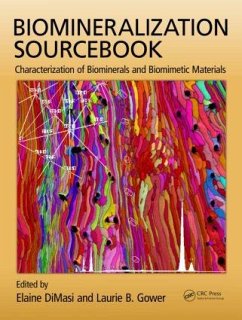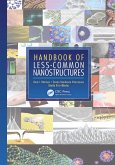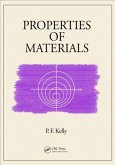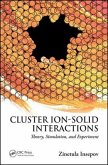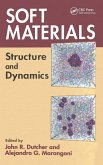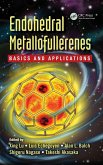Biomineralization Sourcebook
Characterization of Biominerals and Biomimetic Materials
Herausgeber: Dimasi, Elaine; Gower, Laurie B
Biomineralization Sourcebook
Characterization of Biominerals and Biomimetic Materials
Herausgeber: Dimasi, Elaine; Gower, Laurie B
- Gebundenes Buch
- Merkliste
- Auf die Merkliste
- Bewerten Bewerten
- Teilen
- Produkt teilen
- Produkterinnerung
- Produkterinnerung
This handbook provides a comprehensive account of materials science approaches to characterization of biominerals and biomimetic model systems. It covers state-of-the-art in the characterization of atomic and molecular structure, including the latest in diffraction, scattering, and spectroscopy, in addition to methods for imaging morphology and interfaces. It also looks at computational approaches and probes for examining energetics and forces in assembly. The final section focuses on mechanical function and measurement methodology as well as studies of live cells and whole organ.
Andere Kunden interessierten sich auch für
![Handbook of Less-Common Nanostructures Handbook of Less-Common Nanostructures]() Boris I KharisovHandbook of Less-Common Nanostructures283,99 €
Boris I KharisovHandbook of Less-Common Nanostructures283,99 €![Nanomaterials Handbook Nanomaterials Handbook]() Nanomaterials Handbook389,99 €
Nanomaterials Handbook389,99 €![Properties of Materials Properties of Materials]() P F KellyProperties of Materials117,99 €
P F KellyProperties of Materials117,99 €![Cluster Ion-Solid Interactions Cluster Ion-Solid Interactions]() Zinetula InsepovCluster Ion-Solid Interactions205,99 €
Zinetula InsepovCluster Ion-Solid Interactions205,99 €![Soft Materials Soft Materials]() John Dutcher / Alejandro G. MarangoniSoft Materials349,99 €
John Dutcher / Alejandro G. MarangoniSoft Materials349,99 €![Endohedral Metallofullerenes Endohedral Metallofullerenes]() Endohedral Metallofullerenes224,99 €
Endohedral Metallofullerenes224,99 €![Hierarchical Micro/Nanostructured Materials Hierarchical Micro/Nanostructured Materials]() Weiping CaiHierarchical Micro/Nanostructured Materials264,99 €
Weiping CaiHierarchical Micro/Nanostructured Materials264,99 €-
-
-
This handbook provides a comprehensive account of materials science approaches to characterization of biominerals and biomimetic model systems. It covers state-of-the-art in the characterization of atomic and molecular structure, including the latest in diffraction, scattering, and spectroscopy, in addition to methods for imaging morphology and interfaces. It also looks at computational approaches and probes for examining energetics and forces in assembly. The final section focuses on mechanical function and measurement methodology as well as studies of live cells and whole organ.
Produktdetails
- Produktdetails
- Verlag: CRC Press
- Seitenzahl: 432
- Erscheinungstermin: 25. Februar 2014
- Englisch
- Abmessung: 282mm x 218mm x 28mm
- Gewicht: 1247g
- ISBN-13: 9781466518353
- ISBN-10: 1466518359
- Artikelnr.: 40032854
- Herstellerkennzeichnung
- Libri GmbH
- Europaallee 1
- 36244 Bad Hersfeld
- gpsr@libri.de
- Verlag: CRC Press
- Seitenzahl: 432
- Erscheinungstermin: 25. Februar 2014
- Englisch
- Abmessung: 282mm x 218mm x 28mm
- Gewicht: 1247g
- ISBN-13: 9781466518353
- ISBN-10: 1466518359
- Artikelnr.: 40032854
- Herstellerkennzeichnung
- Libri GmbH
- Europaallee 1
- 36244 Bad Hersfeld
- gpsr@libri.de
Elaine DiMasi is a physicist and synchrotron x-ray scattering expert, and has made her career at Brookhaven National Laboratory since 1996. Research for her PhD (University of Michigan, Ann Arbor) and postdoctoral appointment (BNL) focused on structure and electronic properties in metallic condensed matter systems. Since 1999 she has investigated numerous aspects of Biomineralization including: mineralization at Langmuir films, assembly and mineralization of extracellular matrix proteins, structures of organics assembled on mineral surfaces, and microbeam diffraction mapping of mineral-organic composites and biological minerals. More recent areas of interest include lipid-mineral interactions and soft X-ray microspectroscopy. DiMasi currently is engaged in building a state of the art synchrotron x-ray scattering facility at the National Synchrotorn Light Source II, dedicated to soft- and bio-materials, specializing in aqueous interfaces, providing the capabilities to measure hierarchical structures of biominerals for a wide range of length scales and in realistic material environments. Laurie B. Gower is an Associate Professor in the Department of Materials Science & Engineering, and supervisor of the Biomimetics Laboratory at the University of Florida. Her Master's degree from University of Utah was in the area of Bioengineering (1990), and doctoral degree from UMASS at Amherst was in the area of Polymer Science & Engineering (1997). In the latter case, her dissertation was focused on biomineralization, making use of model systems to examine the interactions between polypeptides and crystal growth, and correlating features observed in the in vitro systems to those observed in biominerals. Most of the research in her academic career has continued along these lines of examining potential mechanisms involved in biomineralization. She discovered a novel crystallization process that relies on a polymer-induced liquid-precursor (PILP) phase, and was one of the first to suggest that biominerals might be formed from a hydrated amorphous precursor. She has built a line of evidence to suggest that this polymer-directed crystallization process may play a fundamental role in both calcium carbonate (marine exoskeletons) and calcium phosphate (bones and teeth) biomineralization, as well as calcium oxalate precipitation in kidney stones.
Characterization of Atomic and Molecular Structure: Diffraction and
Scattering
Synchrotron X-Ray Scattering: Probing Structure for the Structure-Function
Relationship In situ X-ray scattering from molecular templates and
nucleating minerals at organic-water interfaces Electron Backscatter
Diffraction for Biomineralization
Characterization of Atomic and Molecular Structure: Spectroscopy and
Spectro-MicroscopyInfrared Spectroscopy and Imaging Raman Spectroscopy in
Biomineralization
Chemical Mapping with X-Ray Absorption Spectroscopy
Local Structure Development; Characterization of Biominerals Using X-Ray
Absorption Spectroscopy Soft x-Ray Scanning Transmission Spectro-Microscopy
Photoemission Spectromicroscopy for the Biomineralogist
Solid-State NMR Spectroscopy: A Tool for Molecular-Level Structure Analysis
and Dynamics The Realities of Disordered or Unfolded Proteins: Relevance to
Biomineralization Imaging Morphology and InterfacesExploring Dynamics at
the Biomolecule-Crystal Interface Using Real-Time In Situ Atomic Force
Microscopy
In situ Atomic Force Microscopy as a tool for investigating assembly of
protein matrices Transmission Electron Microscopy in Biomineralization
Research: Advances and Challenges X-Ray Computed Tomography SIMS Method and
Example of Applications in Coral Biomineralization Properties of the
Composite: Energetics and Forces in AssemblyMolecular Simulation of
Biomineral Nucleation And Crystal Growth: Modern Computational Challenges
and Approaches Application of Enhanced Sampling Approaches to the Early
Stages of Mineralization Direct Measurement of Interaction Forces and
Energies with Proximal Probes Properties of the Composite: Materials
Approaches to Tissues and Whole OrgansMeasuring Forces between Structural
Elements in Composites: From Macromolecules to Bone Mechanical and
Interface Properties of Biominerals: Atomistic to Coarse Grained Modeling
Whole Organ Deformation Analysis by Digital Optical Metrology Methods
Illustrating Biodiversity: The Power of an Image
Scattering
Synchrotron X-Ray Scattering: Probing Structure for the Structure-Function
Relationship In situ X-ray scattering from molecular templates and
nucleating minerals at organic-water interfaces Electron Backscatter
Diffraction for Biomineralization
Characterization of Atomic and Molecular Structure: Spectroscopy and
Spectro-MicroscopyInfrared Spectroscopy and Imaging Raman Spectroscopy in
Biomineralization
Chemical Mapping with X-Ray Absorption Spectroscopy
Local Structure Development; Characterization of Biominerals Using X-Ray
Absorption Spectroscopy Soft x-Ray Scanning Transmission Spectro-Microscopy
Photoemission Spectromicroscopy for the Biomineralogist
Solid-State NMR Spectroscopy: A Tool for Molecular-Level Structure Analysis
and Dynamics The Realities of Disordered or Unfolded Proteins: Relevance to
Biomineralization Imaging Morphology and InterfacesExploring Dynamics at
the Biomolecule-Crystal Interface Using Real-Time In Situ Atomic Force
Microscopy
In situ Atomic Force Microscopy as a tool for investigating assembly of
protein matrices Transmission Electron Microscopy in Biomineralization
Research: Advances and Challenges X-Ray Computed Tomography SIMS Method and
Example of Applications in Coral Biomineralization Properties of the
Composite: Energetics and Forces in AssemblyMolecular Simulation of
Biomineral Nucleation And Crystal Growth: Modern Computational Challenges
and Approaches Application of Enhanced Sampling Approaches to the Early
Stages of Mineralization Direct Measurement of Interaction Forces and
Energies with Proximal Probes Properties of the Composite: Materials
Approaches to Tissues and Whole OrgansMeasuring Forces between Structural
Elements in Composites: From Macromolecules to Bone Mechanical and
Interface Properties of Biominerals: Atomistic to Coarse Grained Modeling
Whole Organ Deformation Analysis by Digital Optical Metrology Methods
Illustrating Biodiversity: The Power of an Image
Characterization of Atomic and Molecular Structure: Diffraction and
Scattering
Synchrotron X-Ray Scattering: Probing Structure for the Structure-Function
Relationship In situ X-ray scattering from molecular templates and
nucleating minerals at organic-water interfaces Electron Backscatter
Diffraction for Biomineralization
Characterization of Atomic and Molecular Structure: Spectroscopy and
Spectro-MicroscopyInfrared Spectroscopy and Imaging Raman Spectroscopy in
Biomineralization
Chemical Mapping with X-Ray Absorption Spectroscopy
Local Structure Development; Characterization of Biominerals Using X-Ray
Absorption Spectroscopy Soft x-Ray Scanning Transmission Spectro-Microscopy
Photoemission Spectromicroscopy for the Biomineralogist
Solid-State NMR Spectroscopy: A Tool for Molecular-Level Structure Analysis
and Dynamics The Realities of Disordered or Unfolded Proteins: Relevance to
Biomineralization Imaging Morphology and InterfacesExploring Dynamics at
the Biomolecule-Crystal Interface Using Real-Time In Situ Atomic Force
Microscopy
In situ Atomic Force Microscopy as a tool for investigating assembly of
protein matrices Transmission Electron Microscopy in Biomineralization
Research: Advances and Challenges X-Ray Computed Tomography SIMS Method and
Example of Applications in Coral Biomineralization Properties of the
Composite: Energetics and Forces in AssemblyMolecular Simulation of
Biomineral Nucleation And Crystal Growth: Modern Computational Challenges
and Approaches Application of Enhanced Sampling Approaches to the Early
Stages of Mineralization Direct Measurement of Interaction Forces and
Energies with Proximal Probes Properties of the Composite: Materials
Approaches to Tissues and Whole OrgansMeasuring Forces between Structural
Elements in Composites: From Macromolecules to Bone Mechanical and
Interface Properties of Biominerals: Atomistic to Coarse Grained Modeling
Whole Organ Deformation Analysis by Digital Optical Metrology Methods
Illustrating Biodiversity: The Power of an Image
Scattering
Synchrotron X-Ray Scattering: Probing Structure for the Structure-Function
Relationship In situ X-ray scattering from molecular templates and
nucleating minerals at organic-water interfaces Electron Backscatter
Diffraction for Biomineralization
Characterization of Atomic and Molecular Structure: Spectroscopy and
Spectro-MicroscopyInfrared Spectroscopy and Imaging Raman Spectroscopy in
Biomineralization
Chemical Mapping with X-Ray Absorption Spectroscopy
Local Structure Development; Characterization of Biominerals Using X-Ray
Absorption Spectroscopy Soft x-Ray Scanning Transmission Spectro-Microscopy
Photoemission Spectromicroscopy for the Biomineralogist
Solid-State NMR Spectroscopy: A Tool for Molecular-Level Structure Analysis
and Dynamics The Realities of Disordered or Unfolded Proteins: Relevance to
Biomineralization Imaging Morphology and InterfacesExploring Dynamics at
the Biomolecule-Crystal Interface Using Real-Time In Situ Atomic Force
Microscopy
In situ Atomic Force Microscopy as a tool for investigating assembly of
protein matrices Transmission Electron Microscopy in Biomineralization
Research: Advances and Challenges X-Ray Computed Tomography SIMS Method and
Example of Applications in Coral Biomineralization Properties of the
Composite: Energetics and Forces in AssemblyMolecular Simulation of
Biomineral Nucleation And Crystal Growth: Modern Computational Challenges
and Approaches Application of Enhanced Sampling Approaches to the Early
Stages of Mineralization Direct Measurement of Interaction Forces and
Energies with Proximal Probes Properties of the Composite: Materials
Approaches to Tissues and Whole OrgansMeasuring Forces between Structural
Elements in Composites: From Macromolecules to Bone Mechanical and
Interface Properties of Biominerals: Atomistic to Coarse Grained Modeling
Whole Organ Deformation Analysis by Digital Optical Metrology Methods
Illustrating Biodiversity: The Power of an Image

